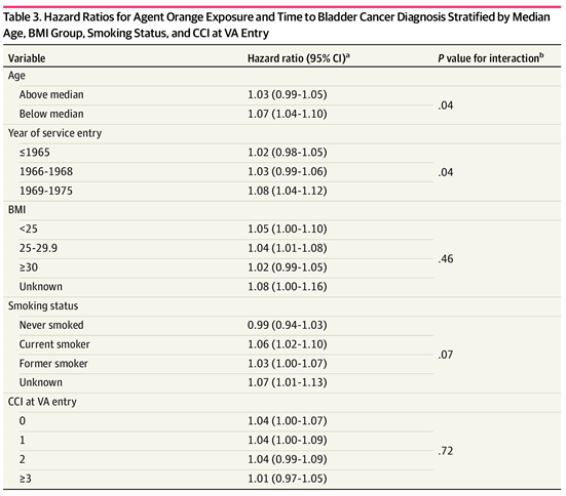
Click to Enlarge: Abbreviations: BMI, body mass index (calculated as weight in kilograms divided by height in meters squared); CCI, Charlson Comorbidity Index; VA, Veterans Affairs.
a. Hazard ratio for Agent Orange exposure (yes) among given group estimated from multivariable model with interaction term.
b. Corresponds to P value from interaction term between Agent Orange exposure and the given variable in multivariable model adjusted for the covariates in Table 2. Source: JAMA Network Open
DURHAM, N.C. — U.S. veterans who were exposed to Agent Orange have a modestly increased risk of bladder cancer, according to a recent study, which also found that younger Vietnam veterans appeared to be in the most peril.
The retrospective cohort study published in JAMA Network Open examined the association between exposure to Agent Orange and the risk of bladder cancer or the aggressiveness of bladder cancer in male U.S. Vietnam veterans. Because data are limited concerning the association between Agent Orange exposure and bladder cancer outcomes, the Institute of Medicine concluded this area of research was needed, the study reported.1
Researchers involved with the study were affiliated with Durham, NC, VAMC.
In the United States, 81,180 new cases of bladder cancer and 17,100 deaths from bladder cancer were estimated for 2022. Most patients with bladder cancer receive a diagnosis of nonmuscle-invasive disease (clinical stage T1 or less), but about 20% to 40% of patients either present with or later develop muscle-invasive disease, according to the study.
Smoking is one of the strongest bladder cancer risk factors, but other risk factors include older age, male sex and exposure to carcinogens, such as aromatic amines, inorganic arsenic and polycyclic aromatic hydrocarbons. Many bladder cancer cases can’t be explained by known risk factors, however, so there’s a need to identify new causative issues. Agent Orange recently has been linked as a risk factor, but only limited data are available regarding the association of Agent Orange with bladder cancer risk and mortality, according to the study.
Using data from the VA Informatics and Computing Infrastructure (VINCI), the researchers identified more than 2.5 million male Vietnam veterans who were treated nationwide in the VHA from Jan. 1, 2001, to Dec. 31, 2019. The median age at VA entry was 60 years old.
Of these participants, 629,907 veterans (25.0%) had Agent Orange exposure, and 1,888,019 were matched veterans (75.0%) without Agent Orange exposure. Veterans exposed to Agent Orange had documented exposure to Agent Orange-containing herbicide agents during active military duty. They were matched in a 1:3 ratio to unexposed veterans on age, race and ethnicity, military branch and year of service entry, according to the study.
When measuring outcomes, “risk of bladder cancer was measured by incidence and aggressiveness of bladder cancer was measured by muscle-invasion status using a natural language processing model,” according to the authors. The previously developed model was “based on pathology reports to determine muscle invasion (yes or no) at the time of diagnosis,” they wrote.
Modestly Increased
The study found a “modestly increased risk of bladder cancer, but not aggressiveness of bladder cancer, among veterans exposed to Agent Orange. Exposure to Agent Orange was associated with a significantly increased risk of bladder cancer, although the association was very slight,” the researchers advised.
“The findings suggest an association between exposure to Agent Orange and bladder cancer, but the clinical relevance of this was unclear,” according to the study.
“We found modest increased risk of bladder cancer but decreased incidence of aggressive disease when diagnosed,” Stephen B. Williams, MD, a researcher at Durham, NC, VAMC told U.S. Medicine. Williams also is associate chief medical officer at the University of Texas Medical Branch (UTMB) Clear Lake, medical director for High Value Care at UTMB Health System and chief of the Division of Urology and professor of urology and radiology at The University of Texas Medical Branch.
The analysis also found some differences based on the race and age of patients. Black veterans “had decreased risk of bladder cancer, but more aggressive disease when diagnosed. Overall, bladder cancer risk among all veterans increased among younger veterans” (less than 60 years old), Williams explained.
The researchers pointed out that “Agent Orange was associated with a 4% increased risk of bladder cancer, which depended on age and year of service entry. Also, Agent Orange was associated with a 7% increased risk of bladder cancer for veterans younger than the median age at VA entry, but no significant association was seen for veterans older than the median age.”
In addition, the study found that “among veterans with a diagnosis of bladder cancer, Agent Orange was associated with lower odds of muscle-invasive bladder cancer.”
The study’s most important finding, that Agent Orange is associated with an increased risk of bladder cancer, supports the VA designation of bladder cancer as an Agent Orange-associated disease. Williams noted that the results would have an impact on the benefits and screenings of veterans exposed to Agent Orange and their family members.
Based on the results, “younger Vietnam veterans exposed to Agent Orange, who have potentially more life-years to develop bladder cancer, were at greatest risk. This finding is critical, because bladder cancer is more commonly diagnosed in older individuals. Targeted screening could be implemented among people exposed to Agent Orange to detect bladder cancer earlier when it is more treatable,” the study recommended.
- Williams SB, Janes JL, Howard LE, Yang R, De Hoedt AM, Baillargeon JG, Kuo YF, Tyler DS, Terris MK, Freedland SJ. Exposure to Agent Orange and Risk of Bladder Cancer Among US Veterans. JAMA Netw Open. 2023 Jun 1;6(6):e2320593. doi: 10.1001/jamanetworkopen.2023.20593. PMID: 37368398; PMCID: PMC10300690.


